Alright, folks, let’s get down to it. Cherimoya and Custard Apple are squaring off.
Remember that time we all tried to pick the “best fruit” at that dodgy market? Same vibes here. These two are cousins in the fruit family, and they’re both weirdly delicious.
Cherimoya brings a creamy texture that’s like eating sweet, tropical clouds. On the other side, Custard Apple, also a creamy contender, has a taste that makes you think, “Am I eating candy or fruit?”
We’ve all been there, picking fruit and hoping it doesn’t taste like cardboard. This is our shot to get it right.
No losers here, just a fun fruit face-off.

What is Cherimoya?
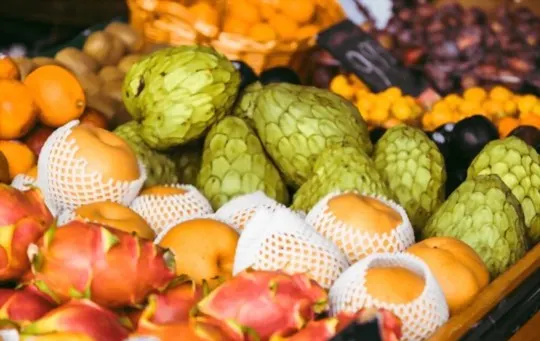
Cherimoya, a semi-tropical fruit with green scales on its exterior, is native to the Andean region of South America.
Its creamy white flesh is fragrant and juicy with a sweet taste reminiscent of pineapple and banana.
As a nutrient-dense fruit, cherimoya is rich in antioxidants, fiber and various vitamins such as C and B6.
It’s also low in calories and fat, making it an excellent addition to a healthy lifestyle.
What is Custard Apple?
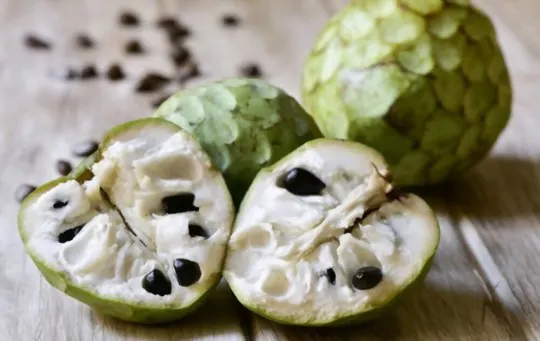
Custard apple is a unique fruit with soft and sweet pulp, which is typically consumed fresh.
The fruit has a greenish or brownish exterior that is covered in small bumps.
It originates from the family Annonaceae and is referred to as ‘Annona reticulata’ scientifically.
Custard apple belongs to the same genus as cherimoya but has slight differences in taste and appearance.
The fruit is high in calories, fiber, vitamin C, potassium, and magnesium.
It has been used in multiple traditional medicines for its potential anti-inflammatory and antihelminthic properties.
In addition, custard apple contains flavonoids like ancoline and sesquiterpenes like reticuline that are known for their potential anticancer properties.
Moreover, the fibrous seed of the fruit can be used as an insecticide or pesticide.
In many cultures worldwide, custard apples have been considered beneficial in treating various health-related issues such as heart problems, fevers, coughs, colds, and skin irritations.
Physical Differences Between Cherimoya and Custard Apple
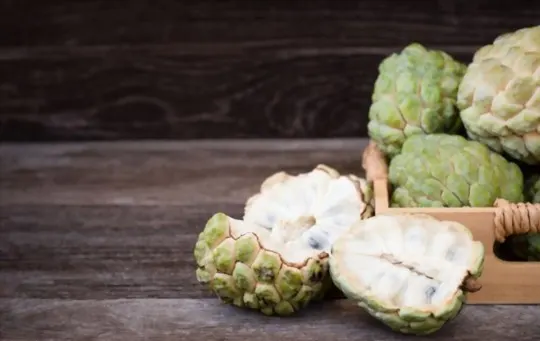
Cherimoya and custard apple are both delightful tropical fruits that differ in their physical attributes.
Cherimoya has a heart-like shape, while the custard apple resembles a bumpy green sack.
Cherimoyas have smooth and scaly skin with greenish-brown hues, whereas custard apples have thick and rough skin with an olive-green color.
Both fruits have white flesh, but cherimoya is creamier and more fragrant than the custard apple.
Additionally, cherimoya seeds are large and black, while those of the custard apple are tiny and brown.
These differences make each fruit unique in its way.
Appearance
Cherimoya and custard apple, although related, differ in their physical appearances.
Cherimoyas are heart-shaped fruits with a scaly, green exterior that changes to brown when ripe.
The fruit has a fragrant aroma and soft white flesh that houses large black seeds.
Conversely, custard apples have a round or ovate shape with a bumpy exterior ranging from light-green to brownish-yellow when matured.
The interior pulp is creamy white or light yellow with smaller seeds embedded in it.
When compared in appearance, cherimoya’s has a unique scaly texture on the outside and softer ivory color pulp than custard apple’s Firmer flesh with chunks of cream tinted and slightly tangy taste.
While both fruits have similar-looking exteriors, their insides have discernable differences in texture and flavor profiles.
Texture
The mouthfeel of Cherimoya and Custard Apple can be compared in terms of their pulp texture.
Cherimoyas have a smooth, creamy pulp with small seeds, while Custard Apples have a slightly grainy pulp with larger seeds.
The difference in texture affects the eating experience and the use of each fruit in recipes.
In terms of texture preferences, it ultimately depends on personal taste and recipe requirements.
However, for those who enjoy a smooth and creamy mouthfeel, Cherimoya may be the better option.
Flavor and Taste Comparison
Cherimoya and Custard Apple are popular fruits with unique tastes.
Cherimoya has a sweet and tangy flavor that is reminiscent of a combination of banana, pineapple, and strawberry.
The flavor of custard apple, on the other hand, is similar to that of vanilla with a sweet taste that is described as sugary.
When compared side by side, Cherimoya has a more complex flavor profile with hints of citrus and floral notes whereas custard apple has a simpler profile with one dominant taste.
Both fruits have high sugar content which contributes to their sweetness.
In terms of texture, cherimoyas are creamier and smoother due to their soft and velvety flesh while custard apples have a fibrous and grainy texture.
This makes cherimoyas preferable for use in smoothies or desserts while custard apples are great for adding texture to salads.
Overall, both fruits offer unique taste experiences but the choice between them depends on individual preferences.
So, try both fruits if you can to decide which suits your taste buds better.
Nutritional Comparison between Cherimoya and Custard Apple
Cherimoya and custard apple are two fruits that often get confused with each other due to their similar appearance.
However, there are some subtle differences between the two in terms of their nutritional value.
Cherimoya is a rich source of dietary fiber, vitamin C, and potassium, while custard apple is packed with antioxidants, calcium, and magnesium.
Both fruits have unique health benefits that make them a good addition to any balanced diet.
When it comes to comparing cherimoya and custard apple, it’s important to consider what nutrients each fruit contains.
Cherimoya has more dietary fiber than custard apple, which is important for digestive health and regulating blood sugar levels.
Additionally, cherimoya is a rich source of vitamin C, an essential nutrient that supports immune function and skin health.
On the other hand, custard apple contains more antioxidants than cherimoya, which can help protect the body against oxidative stress and lower the risk of chronic diseases.
It’s worth noting that both cherimoya and custard apple are relatively high in natural sugars compared to other fruits such as berries or citrus fruits.
As such, it’s important to eat them in moderation as part of a balanced diet that includes plenty of vegetables and lean proteins.
Health Benefits of Cherimoya and Custard Apple
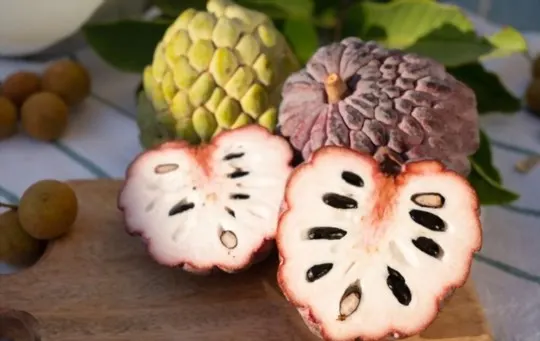
Cherimoya and custard apple are two unique fruits with immense health benefits.
Here are some of the health benefits they possess:
- Both have high levels of vitamin C that boost the body’s immunity against infections.
- Custard apples are rich in antioxidants that protect the body’s cells against damage from free radicals.
- They lower bad cholesterol levels, thanks to their high fiber content and alkaloids, such as anonaine and acetogenins.
- Cherimoyas are an excellent source of potassium that helps regulate blood pressure levels and improve heart health.
- Custard apples reduce the risk of constipation due to their significant fiber content that aids in smooth digestion process.
- These two nutritious fruits provide sufficient amounts of energy to the body without adding extra calories; hence they help in weight loss.
Apart from these, research studies suggest that cherimoyas can keep anxiety at bay while Custard apples improve cognitive function.
These flavorful fruits also offer natural relief from common ailments like colds and flu.
With all these exceptional attributes combined, it is difficult to choose which one outweighs another.
However, both fruits can be a perfect healthy addition to your daily diet plan.
Culinary Uses and Recipes
The fruity delights of both cherimoya and custard apple can be enjoyed in numerous culinary preparations.
These fruits have a unique flesh texture that pairs well with a wide range of sweet and savory dishes.
When it comes to culinary uses, they are versatile ingredients that can be used in various desserts, smoothies, shakes, juices, salads and even curries.
Both cherimoya and custard apple lend sweetness to dishes which are often combined with herbs like mint or basil to add freshness.
Their delicate flavors also work wonders when used in light cream-based custards or puddings, providing a rich texture without being overpowering.
Cherimoya pulp is commonly used as filling for pies and tarts while the custard apple pulp is perfect for mousses or layered cakes.
To get creative with these exotic fruits, one can experiment combining them with other tropical fruits like mango, pineapple or passion fruit.
Notably, these fruits are an excellent source of dietary fiber which helps promote good digestion.
Cherimoya in particular contains high levels of antioxidants that protect against harmful free radicals.
Conversely, custard apples are known for their therapeutic benefits and have been recommended as a natural remedy for various illnesses including fever and diarrhea.
In summary, cherimoya and custard apple make fantastic additions to any kitchen pantry and the possibilities are endless when it comes to using them in cooking.
From pies to puddings and refreshing drinks to health-boosting smoothies; these tropical delights leave no stone unturned when it comes to creating delectable treats at home.
Availability and Where to Find Cherimoya and Custard Apple
Cherimoya and Custard Apple are delicious tropical fruits that are not commonly available in many parts of the world.
These fruits thrive in warm climates, making them more accessible in regions close to the equator.
Those living in exotic locations like South America, Africa, and Asia will find cherimoyas and custard apples in local markets or roadside vendors.
If you’re looking for cherimoyas or custard apples, it’s crucial to check local markets or grocery stores that sell fruit from around the world.
You can also try online shopping at specialty food stores that cater to exotic fruit enthusiasts.
It’s worth noting that both cherimoyas and custard apples have a short shelf life and should be consumed soon after purchase for maximum freshness.
It’s essential to note the seasonality of cherimoyas and custard apples when searching for these fruits.
Cherimoyas usually ripen from September through January, while custard apples are typically available between August and November.
To secure fresh supplies of these delightful tropical fruits out of season, you might consider sourcing from an international supplier.
Conclusion
The comparison between cherimoya and custard apple promises to be a difficult one to decide.
Both fruits have unique attributes that set them apart from each other, making it hard to pick a better option.
Cherimoya is popular for its velvety texture and sweet flavor, while custard apple comes with various health benefits like improving digestion and boosting immunity.
However, the ultimate decision depends on individual preferences and dietary requirements, so it’s important to taste both before choosing.
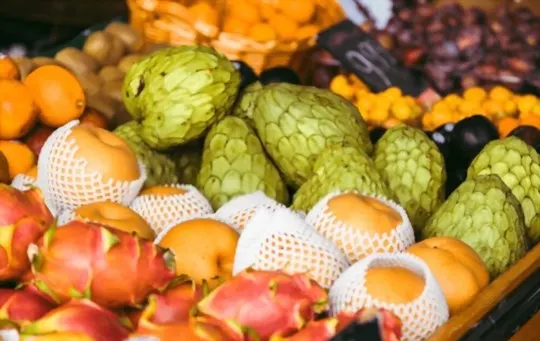
Cherimoya vs Custard Apple: Which is a Better Option?
Ingredients
- Cherimoya
- Custard Apple
Instructions
- Choose between two items based on your preference and availability.
- Follow the cooking directions for your chosen option, using the appropriate ratio of ingredients.
- Prepare it according to your desired recipes.
- Incorporate them into your dish, adjusting the amount to suit your taste.
- Enjoy the unique taste experience and experiment with different dishes to explore their versatility.

Andrew Gray is a seasoned food writer and blogger with a wealth of experience in the restaurant and catering industries. With a passion for all things delicious, Andrew has honed his culinary expertise through his work as a personal chef and caterer.
His love for food led him to venture into food writing, where he has contributed to various online publications, sharing his knowledge and insights on the culinary world. As the proud owner of AmericasRestaurant.com, Andrew covers a wide range of topics, including recipes, restaurant reviews, product recommendations, and culinary tips.
Through his website, he aims to inspire and educate fellow food enthusiasts, offering a comprehensive resource for all things food-related.

Leave a comment